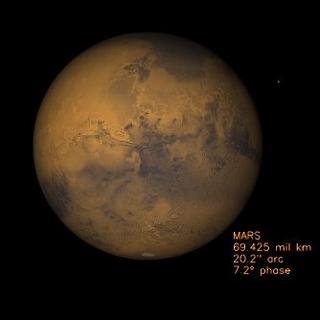Tuesday, October 25, 2005
5 Sleeps until Mars's Closest Approach!
 Rat Phaeochromocytoma cells imaged with a webcam and Steve Mogg's Microscopy adaptor through an Olympus inverted microscope.
Rat Phaeochromocytoma cells imaged with a webcam and Steve Mogg's Microscopy adaptor through an Olympus inverted microscope.As you can see, my Mars observation program is going swimmingly. That is, immersed in large amounts of water. I have observed Mars once in a month and a half due to really horrible weather (which still hasn't given us enough rain to break the drought). The image is of the cells I use to model nerve function, and I must tell you more about them one day, but for now I'll just note that webcams make dandy microscopy systems just as they make dandy astroimaging systems (we have an Umpteen thousand dollar microscopy imager on level 4, but it can't image cells growing in petri dishes, which is what we need for our research). At least my webcam is getting an airing in the run up to Mars's closest approach to Earth.
 Mars as seen at 11:00 pm AEST on October 30, the date of closest approach to Earth. Image generated by the Solar System Simulator.
Mars as seen at 11:00 pm AEST on October 30, the date of closest approach to Earth. Image generated by the Solar System Simulator.Yes, on the Night of Sunday, October 30 Mars will make its closest approach to Earth. Mars's opposition is on November 7, but sometimes opposition and closest approach are at different times. Anyway, on October 30 Mars will be a pleasant 20
Anyway, this time I'm staying home. Mars is fairly easy to spot, it rises reasonably early and can be seen in the north-Eastern sky as a fiery orange object, by far the brightest object there (behind you Venus glows fervidly near the western horizon, the nights really are beautiful). For more details on locating Mars and sky maps, see my Mars Opposition page. No matter how small your scope, you should see something. The accompanying image is that of Mars at closest approach as shown by the Solar System Simulator. There will be a lots of detail to see on the night (as opposed to 2003, which had the most boring hemisphere facing us Aussies). Even if you haven't got a telescope, pester a mate who has, or roll up to one of the planetarium or Astronomical Societies open nights which will occur around this time.
That is, if there is something to see.
 Dust Storms on Mars. Image credit Efrain Morales.
Dust Storms on Mars. Image credit Efrain Morales. From the 18th of October dust storms have sprung up on Mars, making interesting viewing. However, if this keeps up then the entire surface will be shrouded in dust, as happened in 2001. I had missed observations for a few days, and I thought there was something wrong with my telescope until I found out about the storms. More images can be seen at the Marswatch page (WARNING, really big image heavy page).
So we could be in for a vision of featureless disk. But we may see something fantastic. So over the next few night pop out and have a look at the red planet.
And now I am off to bed.
Comments:
<< Home
Mars will be 20 deg in diameter?!!? That is 40 times bigger than the Moon appears in the sky ;-)
I'm guessing that you meant 20 arcseconds (3600 times smaller).
Post a Comment
I'm guessing that you meant 20 arcseconds (3600 times smaller).
<< Home





 Click to read about or order
Click to read about or order Click to read about or order
Click to read about or order Click to read about or order
Click to read about or order Click to read about or order
Click to read about or order




